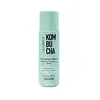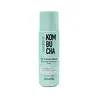What's inside
What's inside
 Key Ingredients
Key Ingredients

 Benefits
Benefits

 Concerns
Concerns

 Ingredients Side-by-side
Ingredients Side-by-side

Water
Skin ConditioningDecyl Glucoside
CleansingSodium Cocoyl Isethionate
CleansingCocamidopropyl Betaine
CleansingCaprylyl/Capryl Glucoside
CleansingGlycerin
HumectantPEG-120 Methyl Glucose Dioleate
EmulsifyingPhenoxyethanol
PreservativeSodium Chloride
MaskingCoconut Acid
CleansingSodium Isethionate
CleansingCitric Acid
BufferingSaccharomyces/Xylinum/Black Tea Ferment
Skin ConditioningEthylhexylglycerin
Skin ConditioningPolyquaternium-10
Ceramide Ng
Skin ConditioningGlyceryl Oleate
EmollientCichorium Intybus Root Extract
MaskingPentylene Glycol
Skin ConditioningSodium Hyaluronate
HumectantWater, Decyl Glucoside, Sodium Cocoyl Isethionate, Cocamidopropyl Betaine, Caprylyl/Capryl Glucoside, Glycerin, PEG-120 Methyl Glucose Dioleate, Phenoxyethanol, Sodium Chloride, Coconut Acid, Sodium Isethionate, Citric Acid, Saccharomyces/Xylinum/Black Tea Ferment, Ethylhexylglycerin, Polyquaternium-10, Ceramide Ng, Glyceryl Oleate, Cichorium Intybus Root Extract, Pentylene Glycol, Sodium Hyaluronate
Water
Skin ConditioningGlycerin
HumectantHamamelis Virginiana Water
AstringentNiacinamide
SmoothingPhenoxyethanol
PreservativeLactic Acid
BufferingGlycolic Acid
BufferingSaccharomyces/Xylinum/Black Tea Ferment
Skin ConditioningEthylhexylglycerin
Skin ConditioningBenzoic Acid
MaskingAloe Barbadensis Leaf Extract
EmollientCucumis Sativus Fruit Extract
EmollientBakuchiol
AntimicrobialBisabolol
MaskingPolysorbate 20
EmulsifyingIngredients Explained
These ingredients are found in both products.
Ingredients higher up in an ingredient list are typically present in a larger amount.
Ethylhexylglycerin (we can't pronounce this either) is commonly used as a preservative and skin softener. It is derived from glyceryl.
You might see Ethylhexylglycerin often paired with other preservatives such as phenoxyethanol. Ethylhexylglycerin has been found to increase the effectiveness of these other preservatives.
Glycerin is already naturally found in your skin. It helps moisturize and protect your skin.
A study from 2016 found glycerin to be more effective as a humectant than AHAs and hyaluronic acid.
As a humectant, it helps the skin stay hydrated by pulling moisture to your skin. The low molecular weight of glycerin allows it to pull moisture into the deeper layers of your skin.
Hydrated skin improves your skin barrier; Your skin barrier helps protect against irritants and bacteria.
Glycerin has also been found to have antimicrobial and antiviral properties. Due to these properties, glycerin is often used in wound and burn treatments.
In cosmetics, glycerin is usually derived from plants such as soybean or palm. However, it can also be sourced from animals, such as tallow or animal fat.
This ingredient is organic, colorless, odorless, and non-toxic.
Glycerin is the name for this ingredient in American English. British English uses Glycerol/Glycerine.
Learn more about GlycerinPhenoxyethanol is a preservative that has germicide, antimicrobial, and aromatic properties. Studies show that phenoxyethanol can prevent microbial growth. By itself, it has a scent that is similar to that of a rose.
It's often used in formulations along with Caprylyl Glycol to preserve the shelf life of products.
This combination of bacteria + black tea + fermentation = kombucha.
According to a manufacturer, this ingredient helps boost radiance, smoothness, and thickens skin.
You can read about the skin benefits of the individual parts here:
Saccharomyces
Black tea
Water. It's the most common cosmetic ingredient of all. You'll usually see it at the top of ingredient lists, meaning that it makes up the largest part of the product.
So why is it so popular? Water most often acts as a solvent - this means that it helps dissolve other ingredients into the formulation.
You'll also recognize water as that liquid we all need to stay alive. If you see this, drink a glass of water. Stay hydrated!
Learn more about Water